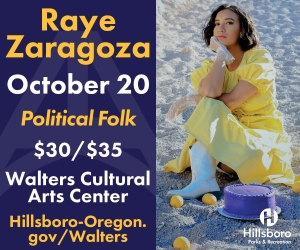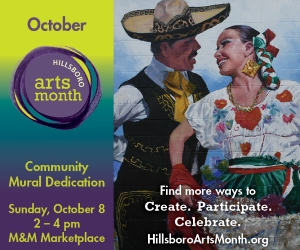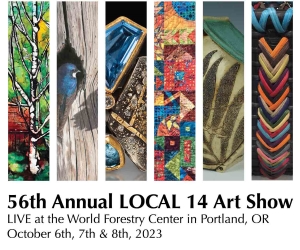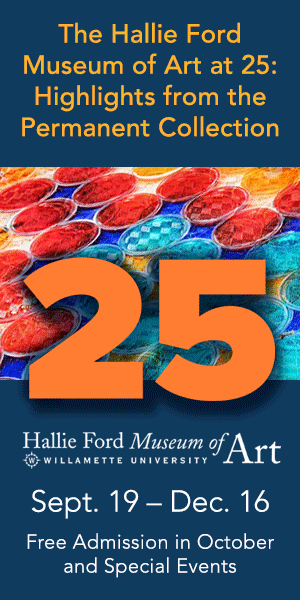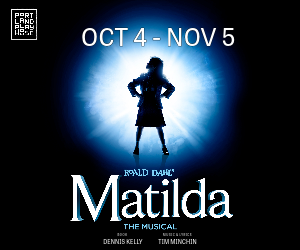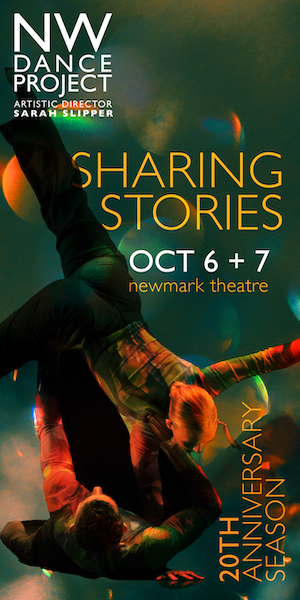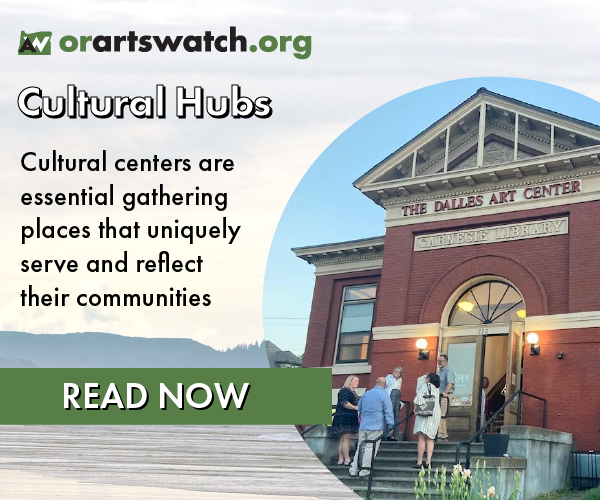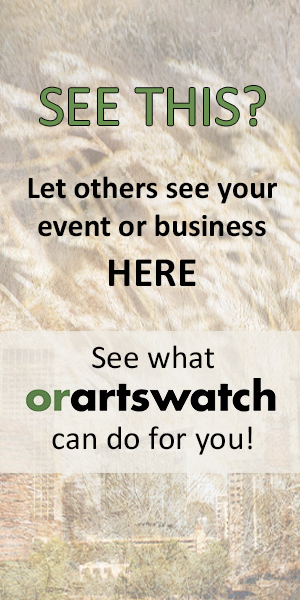
Recent studies have shown that Indigenous women in the United States are more than twice as likely to experience violence as any other demographic, and that, in Canada, the homicide rate for Indigenous women is almost six times as high as the homicide rate for other women. This epidemic of violence, part of an ongoing legacy of racism and colonialism, is just one of several crises facing First Peoples and Indigenous communities today.
Violence against women, as well as the pandemic, climate change, and other human health threats and human rights injustices, are at the core of the current exhibit at the Center for Native Arts & Cultures in Southeast Portland. Protection: Adaptation & Resistance, on view through August 4, explores these existential threats and the response to them through more than two dozen pieces by 52 Alaskan Native artists.
Organized by the Bunnell Street Arts Center in Homer, Alaska, the exhibit is central to the mission of the Native Arts and Cultures Foundation, the parent organization behind the Center. “First Peoples, including our talented Alaska Native relatives, bring millenia of learning and perspective to a diversity of artistic mediums that electrify the imagination,” noted T. Lulani Arquette, president and CEO of the Foundation. “Presenting the Alaska Native Protection Exhibit in our Center aligns with our mission to support and lift up the work of Native artists and culture bearers who are creating positive social change and healing communities.”

Through three themes — Land and Culture Protectors; Activists for Justice and Sovereignty; and Resilient Futures– the artists, solo and in groups, draw upon the Ingenious values of community and collaboration as tools of resistance and adaptation, as well as powerful cultural affirmation and deep respect for nature. Some artists explore these contemporary themes in traditional art forms such as cedar bark hats, woven bark baskets, soapstone, tattoos, and regalia. Others express traditional stories through modern design, graphic novels, postage stamps, and graphic art posters. All of the works reflect the passing forward of Indigenous values of community, collaboration, mentorship, and resilience.
“We focus on the good of the whole community, not for the individual. We collaboratively hunt, fish, share harvests, raise children, and protect our elders. We rely on each other, and we must work together. We take care of each other. For survival. For the well-being of all.” – Lily Hope, Mentor Weaver of the Raven T’akdeintaan Clan
Healing and resistance
Hanging on the south wall of the main gallery is Yup’ik artist Amber Webb’s 12-foot-high “Memorial Qaspeq,” a hooded shirt known as a qaspeq in Yup’ik and as an atikluk in Iñupiaq. Traditionally, qaspeqs were made from animal intestines or seal or bird skin, designed to offer protection to the wearer in the harsh conditions of arctic Alaska. Webb’s “Memorial Qaspeq” is made from cotton bedsheets, hand-sewn together to create the oversized garment. Using black ink and the white sheets as her canvas, Webb has drawn the faces of more than 200 women, each of whom is among the missing and murdered Indigenous women and girls (MMIWG) from Alaska and Canada over the past decades.

The work is riveting, and the viewer can’t help but be drawn forward to look directly into the individual faces of these women – some smiling, some stoic – each the victim of violence and oppression. Webb describes the project as being about “healing myself and sparking healing for all Native women.”

Webb’s use of the qaspeq as a symbol of healing and resilience is carried on by a collective of textile artists in “Healing Stitches.” Six crimson red qaspeqs hang in a circle, where they pay tribute to the love and loss of loved ones. The installation is also of note for how Native Alaskan artists are using technology to both create and connect. Using Zoom, Bobby Qalutaksraq Brower (Iñupiaq, Utqiaġvik) invited Indigenous women from across Alaska to come together and learn to sew the garments in memory of MMIWG.
“Inuit culture and my Ancestors guide my work, but I am most inspired by our lives today and the way we live in two worlds, one old and the modern urban life.” – Holly Mititquq Nordlum, Iñupiaq tattoo artist
Adjacent to the qaspeqs are photographs depicting the work of contemporary Native Alaskan artists who are reviving the ancient practice of Inuit tattoo. In increasing numbers across Alaska, Indigenous women are embracing this traditional rite of passage as expressions of cultural identity and solidarity. The power of the markings on their living canvases speaks to a new generation of women who are declaring their strength and eschewing victimization.

New technologies and ancient traditions
During the pandemic, several other artists also employed Zoom to bring communities of artists together and adapt traditional images and tools to create new works, including Chilkat Protector masks, Lingit and Haida cedarbark hats, and soapstone oil lamps. The use of technology not only allowed artists to come together, collaborate, and learn, but also ensures that the old ways and traditions continue to be revitalized and passed from elders to the next generations. In a land that is geographically expansive with locations often difficult to access, technologies like Zoom provide an invaluable and lasting resource for connection among the First Peoples of Alaska.
“My parents’ generation was punished for learning their culture. I don’t want the knowledge to die with me. Hat making is what we do. It’s generational, handed down through my family. It is how we celebrate and perpetuate our culture.” — Kunagoo Linda Starbard, Lingit weaver
The Covid pandemic appears throughout several works, including Lingit artist Crystal Rose Demientieff Worl’s “Haa Shagéinyaa: Our Protecting Power,” a series of posters that draw from her own Lingit design traditions in strikingly modern graphics to support public health, masks, and vaccines. “With these prints I aim to promote public health and wellness specifically in Indigenous communities, which are most vulnerable to the pandemic,” she noted. “We have the choice and capability to resist the virus and adapt with modern tools as a means to protect our loved ones. It is in our power to protect, adapt, and resist.”

In “We’re Still Here,” Naal xak’w / Tommy Joseph created the alder and wood animal masks to fit over N95 masks, using a cultural tradition to encourage mask-wearing, particularly among elders. “Animals impart a level of protection,” noted Joseph, who is Lingit. “The animals are spirit helpers; they guide you in your journey. If we pay attention, they can teach us. We share the land waters with them. It’s up to us to protect them.”


Left: “We’re Still Here,” by Lingit artist Tommy Joseph. Right: close-up of “We’re Still Here.” Photos: Bert Franks.
Passing history to future generations
Lingit history is told through songs, dance, and stories. “Kaxhatjaa X’óow / Herring Protectors” are dance robes that tell the story of the Herring Rock Woman, who sang to Yaaw, the herring, until they schooled and laid eggs in her hair. Created by a collective of artists, the life-sized robes are decorated with a variety of elements, each of which has significance. For example, the robes’ silk lining and the mother-of-pearl buttons evoke the waters where herring spawn and the eggs they lay. Both are from WW2 era Japan, an acknowledgement of the extinction of the herring population due to overfishing.

The result is a powerful and poignant call for the protection of the herring, a vital food source in Alaska and an integral part of the greater ecosystem. “The herring, which mean so much to our culture and our ecosystem are being depleted all for what? Money? Greed? Without herring nothing is supporting the ocean. The whales. The salmon. Without herring, there is nothing supporting us,” said K’asheechtlaa/Louise Brady, one of the several artists who designed and constructed the robes.
“Within the Native peoples of Alaska, there is tremendous diversity, but we have all survived the oppressions of colonization, especially the restrictions against subsistence. Calling on our ancestors or spirit helpers can help us to survive.” – Tommy Joseph, wood carver
In “Chickaloonies,” humor, heroism, and hope mix with tribal legends in the very contemporary art form of the graphic novel. The work of Ahtna artist Dimi Macheras and his collaborator and co-founder of 80% Studios, Casey Silver, “Chickaloonies” was inspired by Macheras’s childhood spent hearing traditional legends from his Chickaloon Village elders and about their Ahtna Athabascan (Dene’) language, values, and culture.

“We set our sights on creating a story based on my Ahtna heritage, but we didn’t want to retell old stories,” said Macheras. They asked themselves if they could create a new legend based on the themes and values of those timeless Ahtna tales. “The Ahtna were very adaptable people, and their stories contained very important lessons about how to be a good person and ways to live a good life.”

But “Chickaloonies” is much more than a graphic novel: The two artists also incorporated the Ahtna Athabascan language, an oral language which is represented with symbols, into the story itself. In an innovative and meaningful way, they used glyphs to differentiate the oral language from English. “Moji, who communicates with images and emojis, paired up with his best friend, Yelly, who blabs and talks non-stop, create a duo which represents the two pillars of the Graphic Novel medium: words and pictures,” Macheras said. “This allows us to explore how stories not only allow us to connect with the past, but shape our destinies.”
Passing along the generational knowledge, the stories, and the traditional skills from one generation to the next, the artists on view in Protection: Adaptation & Resistance present works that powerfully express and affirm their cultural identities and values, whilst bringing them into the future. They also give all of us cause to celebrate their resilience and hope, as well as extending the invitation to become allies, supporters, and advocates.
Protection: Adaptation & Resistance was made possible in part by a grant from the National Endowment for the Humanities: Sustaining Humanities through the American Rescue Plan in partnership with the Association of Tribal Archives, Libraries, and Museums. The exhibit will be on view later this year at the Tulsa Living Arts in Tulsa, Oklahoma, and the International Folk Art Museum in Santa Fe, New Mexico, before concluding its tour at the Alaska State Museum in Juneau in 2024.
***
- Protection: Adaptation & Resistance is on view from 4 p.m. to 7 p.m. on Fridays through August 4, with special hours from 1pm to 4pm on Saturday, July 15 and Saturday, July 22. The Center for Native Arts and Cultures is located at 800 S.E. 10th Avenue, between Morrison and Belmont in Portland. Street parking is available. Admission is free.








